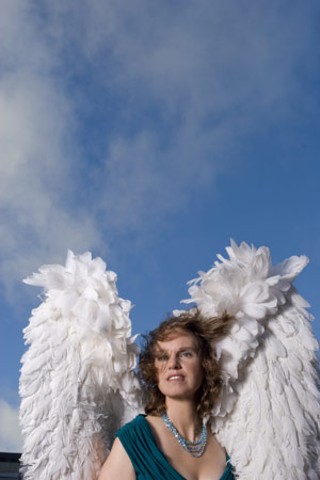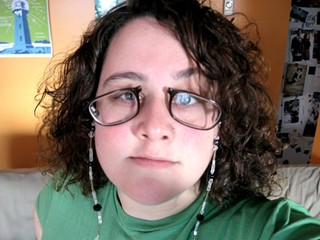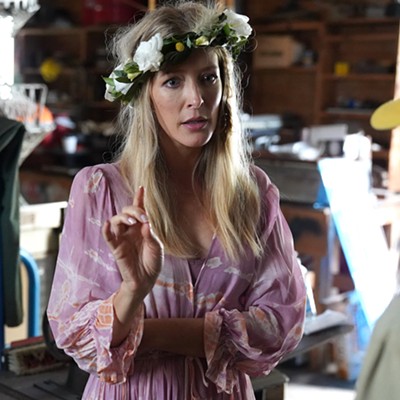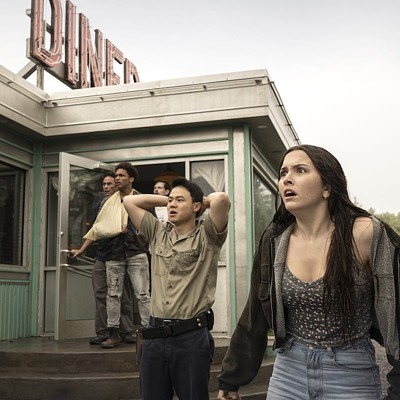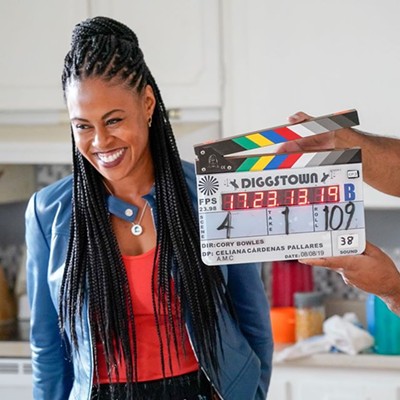In the spectrum of the teen genre, you've got your John Hughes and magic pants and stoners and schmoes and pies, and with many of those---save the pants, really---you've got more than a few erections.
But none of them has ever belonged to an angel before.
"I was just kinda playing that around in my mind---she runs away from him and he suddenly appears and they bang into each other and fall down, and I thought, teenage guy lying on top of a girl, what's that experience like?" says Ann Verrall, the Halifax writer-director of Nonsense Revolution, of a scene early in her film. "Obviously something's going on. So my discovery of the erection element came at the same time as Tess' discovery of it. And then I was like, OK, that just totally changed the story and I understood where the humour could grow from." She pauses. "No pun intended."
Nonsense Revolution, which plays in the Atlantic Film Festival on September 18, is the story of a group splintered by the death of its de facto leader, Caz (Alex House), who's hit by a drunk carload of his friends while running away from a rave the cops have busted up. A year later, none of them has ever discussed it, and Caz comes back to earth in angel form to urge Tess (Anastasia Phillips) to get everybody back together one last time so they can all move on (and consequently let him go).
Since he died with an erection, Kaz is stuck with it---rest assured, it's dealt with as classily as one can deal with such matters--and is also stuck in a sort of sexual vortex. He's visible only to Tess, but discovers people can see him during orgasm, leading to some botched encounters. It's a playful energy that drives the movie, occasionally into crass places, but also symbolic for a group of people in their late teens, some who are questioning their sexuality and/or wanting to lose their virginity.
That's the typical teen movie side of the story. The atypical one is that the crash depicted in the film comes straight from Verrall's life.
Time spent in Calgary after high school in the mid-'80s, Verrall recalls, was druggy and messed up: "I was totally naive---I was in this world I did not belong in," she admits. (Her childhood was a Halifax-Toronto-Hamilton combination that became tumultuous between the Toronto and Hamilton parts.) "I was at a party, hanging out, and I was hungry and said, 'Anyone wanna go get some food?' And these two people I barely knew said 'Sure.' One guy had a car, and we were all, you know, drunk and we got in the car and we went to pick up some food and on the way back we hit this guy who was running across the street. There were two people running across the street and we hit the second one."
A few months after the accident, Verrall returned home to attend NSCAD, where she eventually found and fell in love with video. ("If you wanted to do a shoot outside of the building, it was an amazing athletic achievement," she notes of the pre-digital period.) She produced three long-form shorts in about a decade ("My average is around six years" per project): A 45-minute experimental piece, The Water's Tale, Rain and 2006's 20-minute The Wait, which travelled to the Toronto International Film Festival and can be seen on demand during Air Canada flights.
It was The Wait that ultimately begat Nonsense Revolution. It, too, is about a group of friends dealing with departure. Verrall gathered teens from around the province to workshop a project with the intent to shoot it in the summer of 2003. "Once we started I did a reality check on me and realized I can't do anything fast," she says, laughing as tourists take pictures of flowers in the Public Gardens on a balmy August morning. "I knew I couldn't do a 10-minute piece in a summer. I decided to spend a year developing a longer piece and then try to shoot it next summer." Pause. "Totally not realistic." She laughs again.
The next year she brought in Toronto story editor Carrie Paupst Shaughnessy to assess the progress. "Because the kids were so young---15, 16---and I was just very cautious about the kind of issues and topics I brought up, and because I was working with them so much, I felt uneasy about introducing or promoting the sexual topic, even though it's so much a part of life then," says Verrall. "When she came and read what the story was then, one of her first questions was, 'Where's the sex?' That kind of opened the doorway for that whole discussion."
The Wait is a finely wrought short about the longing and loss of high school, the cross over the invisible line from childhood to adulthood, but "I still wanted to do a feature...there was a whole year between when I shot The Waitand when I worked with those kids," says Verrall. "And the script I shot between that was quite a bit removed from what we had developed, or what I had written when I was actually working with them. I was too connected to them, and I needed to write a script that worked as a script, and not worry about them and what they could or could not do. And then with Nonsense, I really felt that I had to find a story that really worked. The characters that started to emerge out of this next stage of the process were characters that I wanted to create, and they weren't linked to individuals. It was freeing for me."
"It's the most difficult time of life, I think---moving from child to adult."Verrall approached Thom Fitzgerald to produce, and he hooked her up with Daniel MacIvor. "He wanted me to work with a script editor to make it funnier," she says. "Daniel and I both had a laugh about this at one point---his work is very dark. I mean, there's some humour there, but it's dark, and Thom put us together to make it funnier?"
MacIvor's suggestion was an inciting incident. "He said the story of The Wait, that kind of story works better as a short. But in a longer piece, something else needs to happen," says Verrall. "There needs to be some kind of a trigger for peoples' behaviour, it can't just be this angst stuff that is so much a part of being that age. Then that's when the car accident suddenly emerged.
"In the meantime Thom is checking in and I didn't tell him exactly what was happening and he's like, 'Is it funnier yet?' And I said, 'Daniel, how do we make someone dying in a car accident funny?' And he says, 'Well, if they come back to life as a ghost.'
"Suddenly I remembered that I had this little short idea that had an angel in it, so I made him come back as an angel. I wrote this whole version of the script that had the car accident and the angel but it was more in the tone of a Donnie Darko---a little bit creepy. That's the version I gave Thom and he was like, 'This is too depressing. It's a better story, though.'"
The film began shooting in October of last year with a cast of mostly unknowns. Haligonians will recognize the skate park, Point Pleasant and various north end locations. "It was surprisingly the same in some ways," says Verrall of the move from shorts to features. "It wasn't any more difficult, it just was longer. It always felt like something that was doable, and we were doing it, and we did it."
This will be the last kick at the teen can for the filmmaker ("I'm ready to do a story about adults"), but she's still passionate about the subject matter, frequently conducting video workshops with teens around HRM (today she's on a break from a project in Preston).
"When you look at a person's life, that point in time is so crucial, and it feels like at that point someone can either find themselves or not," she says. "And if they don't find themselves then, they could end up dying or getting really lost---it's a crucial moment. It's the most difficult time of life, I think, moving from child to adult, where you don't feel grounded anywhere---you don't feel connected to your family, or being a child or being an adult, you are kind of this nomad, a lost person. You have to prove to yourself, and society, that you can function in this world. There are so many ways that we don't support people at that moment in their lives, and we pay for it---as a society, we pay for it.

